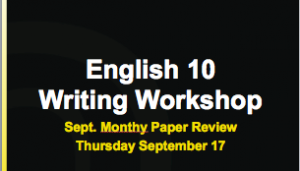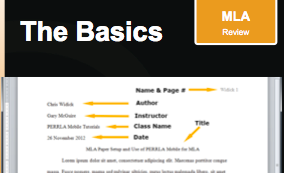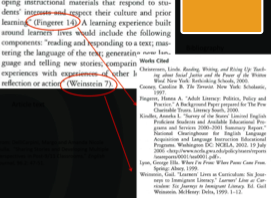Day 28 – Eng. 10
The most common errors on this first monthly paper were covered today in class, and now anyone who turned their paper in on time will have until next Wednesday to correct their errors and submit a new paper for a better grade. The four areas we covered today were the difference between response papers and reports or summaries, How to use Turnitin, a review of the required MLA, and the specifics for the Oct. Monthly Paper.
As discussed earlier, a response paper is not simply a report or summary about someone or something. You are selecting a text to read and then constructing a response paper to that text. What did you get from reading that text? What point do you want to make? What kind of connections can you make after reading that test? In essence, what is your response to reading that text?
Your response paper must be written in essay form, which means a minimum of three paragraphs: An Introduction, At Least One Body Paragraph, and A Conclusion. Your introductory paragraph must includes a hook, the full name of the text read “in quotation marks” with the author’s full name, and your thesis.
New point, after the author is mentioned the first time you only use the last name in academic writing.
Turnitin is not just a place to turn in your paper. It is a place to help you improve your writing.
Everyone opened their graded monthly paper and we walked through the following in class together.
We reviewed both the Originality and the GradeMark reports.
The originality report checks the internet for papers written using the same words or phrases. For Eng. 10 you should never have an originality report that is higher than 24%
Any information that is similar to something from the text you are reading must be cited properly. There are 3 acceptable ways to use information from what you have read: Summarizing, Paraphrased, or Quoting. Regardless of how you use the information, it must be cited to give credit to the author. (Remember the “Why Not to Eat Yellow Snow” video.
Notice the references to your iBook textbook, where you can go to find help on each of these specific issues.
“Summary is a condensed statement, in your own words, of the main meaning of a work. Summaries omit supporting details and examples to focus on the original author’s thesis.”
Excerpt From: “Book Title.” iBooks. Page 77
“A paraphrase is a restatement, again in your own words, of a short passage from another writer’s work.”
Excerpt From: “Book Title.” iBooks. Page 78
While summarizing makes it possible to explain someone else’s main idea without repeating specifics, paraphrasing lets you incorporate important details that support your own main idea.
A paraphrase is about the same length as the original, but it does not use any of the other writer’s unique words, phrasings, or sentence structures.
“Sometimes a writer’s or speaker’s exact words will be so well phrased or so important to your own meaning that you will want to quote them.”
Excerpt From: “Book Title.” iBooks. Page 79
When you are responding to or analyzing passages in a written work, such as an essay or a novel, direct quotations will be essential evidence as you develop your points. Even when you are borrowing ideas from other writers, however, quoting can be useful if the author’s original wording makes a strong impression that you want to share with your readers.
Be sparing in your use of quotations. Limit yourself to those lines you’re analyzing or responding to directly and perhaps a handful of choice passages that would lose their punch or meaning if you paraphrased them.
The GradeMark report checks the basic grammatical structure of your paper. This gives you very basic rules that you may have used improperly, such as spelling, punctuation or subject verb agreement. The purple marks are generated by the program, the blue are marks I have added.
At this point, because you are working on an iPad you must use the small print symbol at the bottom of your paper view. Select the first option and you will be provided with a full report on your screen. We are not always printing these reports off, this is simply a way to allow you to see all of the information provided, including the comments I have made and the rubric used to grade your paper.
Chapter 3 of your text covers writing and your monthly paper. The specific MLA instructions and the introduction video begin on page 76. You can also use the links on the blog or the QR codes in the yellow notebook in class to review specific MLA requirements.
MLA citations from an article with page numbers. Notice where the end punctuation has moved to. Also notice that on this picture example the Works Cited title is not correctly centered.
You are not expected to remember all of the MLA rules. You are expected to know where to find the correct information and make sure your papers are correctly formatted prior to turning them in.
Your October Monthly Paper must be a response to any text you select from a printed Time or The New Yorker magazine. You may select an article, a picture, a comic, an editorial, or anything in the magazine. You may select a magazine from the in class collection and keep it until the Oct. papers are graded.
After the lecture, Everyone was reminded to make an account on Write the World. and join Mrs. Scales’ Room Writing Group. The rough draft or first response to the prompt assigned on Tuesday must be done by the end of school tomorrow. Here is a reminder of the prompt information:
Full Details
What do you believe in? A quick survey of recent This I Believe statements on NPR covered the following topics: baseball, ghosts, poetry, practice and hard work, not wearing make-up, silence, science fiction, and the power of love… as you can see, beliefs can cover just about anything!
Examples
Listen to these wonderful examples, archived by National Public Radio:
Never Give Up
The True Value of Life
Forgiving My Dad
Suggested Length
Your statement of belief can be any length. Perhaps you will write a full essay, or perhaps you will capture the core of your belief in just a handful or words…
Guidelines
NPR gives writers of This I Believe statements the following advice:
Tell a story. Be brief. Name your belief. Be positive. Be personal.
Below are some additional suggestions to consider when writing this reflection:
- Do you tell a story, describe a scene, or draw on a memory to illustrate your belief?
- Do you name your belief?
- Do you draw the reader into your statement by using a hook? Perhaps you launch right into an anecdote. Or perhaps you begin with a surprising statement, a quotation, a statistic or fact, or a rhetorical question.
Don’t Know How to Start?
Try the following…
- Start out by making a list of 5-10 beliefs, mundane or grand.
- For each item on your list, put a star next to the ones that really tug at something inside of you. Which stir up the most emotion, the most conviction?
- Narrow the starred items down to 2-3, and think about a memory that represents or demonstrates where this belief came from or why it is significant in your life. What story can you tell that demonstrates the essence of this belief?
Here is an example of Mrs. Scales’ response draft:
This I Believe – Joy
I believe that joy is the greatest success one can achieve in life. Joy is happiness and a beloved feeling of satisfaction. Joy is something very personal and is not only different for different people, it is different for the the same person at different times in their lives. I can remember a time when pure joy for me came from the back of a horse. Nothing brought me more joy than setting atop my bareback horse with my bare leggs hanging down her sides and my back laying flat against her back. My head rolled softly on her romp and I contemplated the blue sky above. I can also remember the joy that just sitting around my Granny’s old kitchen table drinking coffee with my mom and an aunt or two. I believe that joy, like memories stay with us and revisit us when most needed. I believe that my greatest joys have come from days spent with the ones I love most, my Granny, my sister, my husband, my daughter, my grandchildren, and friends and students I interact with along the way.
I believe that joy can be found in the most common of experiences and by people of all ages and levels of economic or social status. Real success can’t be measured in the level of importance of one’s job, or the amount of their bank account. I believe that real success is measured by how much joy each person accumulates during their life. For some pure joy does come from doing a job that is rewarding and contributes to the world. I believe that the joy of experiencing the achievement and growth of my students does give me great joy. Finding the joy in whatever one is doing is a true mark of success, this I believe.
See you all tomorrow for another Literary Circle Meeting.







